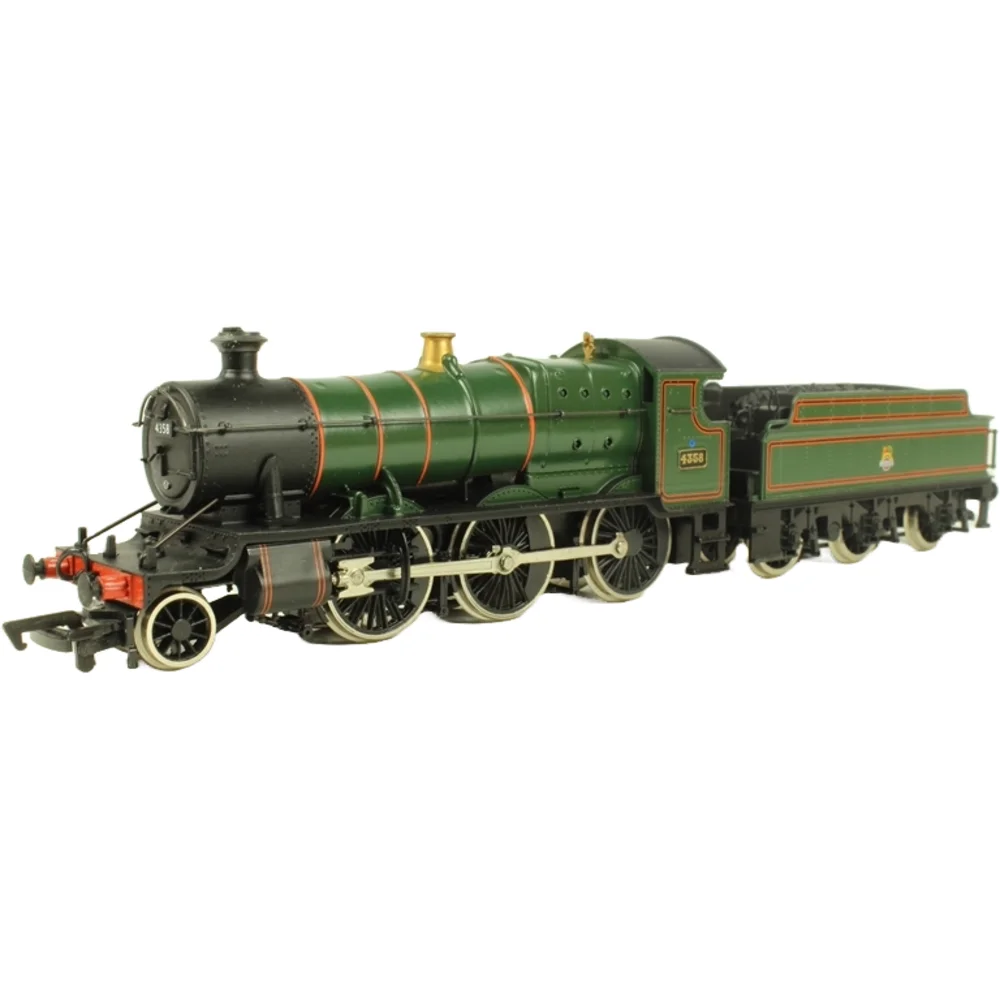Mainline 37045
Great Western Railway 4300 4358 British Railways Lined Green with Early Emblem
Tooling
The Bachmann Branchline model of the Great Western Railway (GWR) 4300 Class 2-6-0 Mogul was introduced in 1996, based on tooling inherited from Mainline Railways. Originally developed by Palitoy/Mainline in the early 1980s, the tooling was later acquired and refined by Bachmann following their entry into the UK market. The model represents Churchward’s mixed-traffic locomotive design, which was built between 1911 and 1932 and became a staple of GWR and later BR operations.
Tooling Features
- Scale: OO gauge (1:76 scale)
- Construction: Plastic bodyshell with separately fitted details; metal chassis
- Detailing: Includes fine valve gear, cab detail, and prototypical tender
- Couplings: Standard tension-lock couplings; NEM pockets not present on early releases
Mechanical & Electrical
- Motor: Ringfield motor mounted in the tender (Mainline/Bachmann split chassis design)
- Drive: Split chassis with drive to locomotive wheels via coupling rods
- Minimum Radius: Compatible with 2nd radius curves (438mm+)
- Lighting: No directional or interior lighting
- Weighting: Moderate weight; traction tyres used on some versions
DCC Capability
- DCC Compatibility: Not DCC-ready; split chassis design makes conversion difficult
- Sound: No sound decoder provision
Liveries Produced
Models have been released in a variety of liveries reflecting both GWR and BR eras:
- GWR Green (lined and unlined)
- BR Black (plain and lined)
- BR Green with early and late crests
Reviews & Commentary
Early reviews praised the model’s appearance and affordability, though criticism was directed at the split chassis mechanism, which was prone to gear splitting and electrical issues over time. The model has a nostalgic following among collectors and GWR enthusiasts, despite its mechanical limitations.
Forum discussions on platforms like New Railway Modellers and ModelRailroadForums highlight the model’s charm and historical significance, while also noting its dated drive system. Some users have undertaken conversions or repairs to extend its operational life.
Media & Social Media
The model has featured in YouTube restoration videos and enthusiast blogs, often showcasing repairs to the split chassis and upgrades to detailing. It remains a popular subject for weathering and customization projects.
Additional Notes
- The tooling has been used for both 4300 and 9300 series variants
- Later models from Dapol and Heljan offer more modern mechanisms and DCC readiness
Class & Prototype
- Class: Great Western Railway 4300
- Traction: Steam
- Built: 1911-1932
- Total Built: 342
- Running Number: 4358
Operator & Livery
- Operator: British Railways
- Livery: Lined Green with Early Emblem
- Era: 4 - British Railways Early Emblem
British Railways transformed Britain's fragmented rail network into a unified national system following nationalisation on 1st January 1948. Created from the "Big Four" companies under the Transport Act 1947, BR operated most of Great Britain's railways until rebranding as British Rail in 1965, managing over 20,000 route miles and inheriting nearly 20,000 locomotives of diverse designs.
The organisation pioneered standardisation through its revolutionary BR Standard locomotive programme (1951-1960), producing 999 advanced steam engines under Robert Riddles' direction. These included the versatile Britannia Pacifics, mighty 9F freight engines, and mixed-traffic classes that incorporated the best features from all predecessor companies. The 1955 Modernisation Plan accelerated diesel and electric traction development, creating fascinating mixed-traction operations.
Notable achievements included establishing unified locomotive classification systems, introducing distinctive corporate liveries, and managing the complex transition from steam to modern traction. BR's six regional structure preserved operational diversity whilst enabling standardisation of practices, signalling, and rolling stock that had eluded private enterprise for over a century.
The BR era represents steam traction's final flowering alongside emerging diesel technology, creating unparalleled locomotive variety. Today, this heritage remains highly popular with railway enthusiasts through extensive preserved fleets, heritage railway operations, and comprehensive model ranges from manufacturers like Hornby, Bachmann, and Dapol, making BR subjects essential for authentic post-war British railway modelling across all scales.
British Railways' lined green livery was designated for express passenger locomotives from 1949, painted in BS224 Deep Bronze Green (also known as Land Rover Deep Bronze Green) with orange and black lining, contrary to popular misconceptions about it being GWR Brunswick Green. Official BR documentation described this as "Dark Green lined Black and Orange" for selected express passenger steam locomotives, with the lining following GWR-style patterns but with distinct BR specifications. The "Lion and Wheel" emblem (nicknamed the "Cycling Lion") adorned these prestigious locomotives from early 1949, showing a lion standing over a spoked wheel with "British Railways" lettering across the centre.
Only the most powerful passenger classes received this elaborate livery—on the Western Region, this included Kings, Castles, and Stars, whilst other regions applied it to their premier express types like Coronations, A4s, A3s, A1s, and Merchant Navy Pacifics. Initially, the most prestigious locomotives of each region were actually painted in Sky Blue with black and white lining, but this proved unpopular and was quickly superseded by the green scheme. The emblem was positioned centrally on tender sides above the middle axle box, with regional variations in size preference—the Western Region favoured larger emblems whilst other regions typically used smaller versions. Lettering and numbering appeared in golden yellow Gill Sans Medium, normally outlined in black where the background wasn't black. This prestigious livery represented BR's finest locomotives until the corporate identity changed in 1956, making it essential for authentic early BR express passenger operations in model form.
